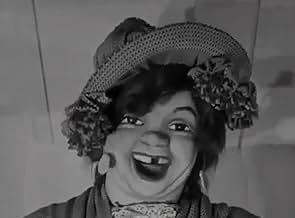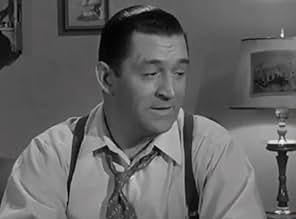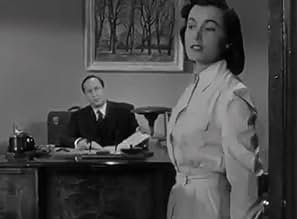AVALIAÇÃO DA IMDb
6,2/10
913
SUA AVALIAÇÃO
Adicionar um enredo no seu idiomaMany interested parties are after the loot from a factory payroll heist but the mobster who hid it has amnesia after undergoing experimental brain surgery in the prison hospital.Many interested parties are after the loot from a factory payroll heist but the mobster who hid it has amnesia after undergoing experimental brain surgery in the prison hospital.Many interested parties are after the loot from a factory payroll heist but the mobster who hid it has amnesia after undergoing experimental brain surgery in the prison hospital.
- Direção
- Roteiristas
- Artistas
Chris Alcaide
- Pursuing Detective
- (não creditado)
Fred Aldrich
- Cop
- (não creditado)
Leonard Bremen
- Guard at Clinic
- (não creditado)
Paul Bryar
- Freddie - Bartender
- (não creditado)
Sayre Dearing
- Patient in Wheelchair at Clinic
- (não creditado)
Frank Fenton
- Detective Driver
- (não creditado)
John Harmon
- Herman
- (não creditado)
Mary Alan Hokanson
- Nurse
- (não creditado)
Shepard Menken
- Interne
- (não creditado)
Howard Negley
- Detective
- (não creditado)
Frank O'Connor
- Gate Guard
- (não creditado)
Avaliações em destaque
After reading some negative reviews of this film, I expected it to be a pretty stale B-movie about gangsters and stolen dough. However, I found this to be a pretty entertaining B-movie with some humorous 3-D effects, and some wonderful footage of an amusement park circa 1953.
The script for this film, is indeed pretty routine with the typical gangster stereotypes seen in most films of the period. Edmund O'Brien gives a very good performance, however. There are also a few other familiar character actors in the film, which make for interesting viewing.
The 3-D gimmicks utilized throughout (scalpels, cigars, guns, a flower pot, roller coaster) are fun to spot, and good for a laugh. The greatest asset this film has though, is it's use of location filming. There is an interesting chase across some rooftops which works very well, but best of all are the amusement park scenes, including a roller coaster ride, and some really nice close-ups of the Fun House Laughing Sal figure. If for no other reason, see the film for her presence.
The script for this film, is indeed pretty routine with the typical gangster stereotypes seen in most films of the period. Edmund O'Brien gives a very good performance, however. There are also a few other familiar character actors in the film, which make for interesting viewing.
The 3-D gimmicks utilized throughout (scalpels, cigars, guns, a flower pot, roller coaster) are fun to spot, and good for a laugh. The greatest asset this film has though, is it's use of location filming. There is an interesting chase across some rooftops which works very well, but best of all are the amusement park scenes, including a roller coaster ride, and some really nice close-ups of the Fun House Laughing Sal figure. If for no other reason, see the film for her presence.
Here's an example of a routine thriller that could have been so much better if the script hadn't been so banal. Unfortunately, nothing really riveting happens until the last twenty minutes when the amnesiac victim enters an amusement park with some startling results.
It's the final chase scene that make the film come to life, but by that time (and even though the running time is brief), many a viewer will be turned off by the pedestrian script and the average performances.
Even old pros like Edmond O'Brien and Audrey Totter look as though they know the script is the problem. Totter, minus her usually scrappy dialog has a colorless role. She plays it straight but makes almost no impression as the woman who wants her boyfriend to amend his old ways after he finds the missing loot that the villains are chasing him for.
It was originally intended to be shown in 3D, and this is obvious from some of the gimmicky B&W photography for the carnival scene. Still, the low-budget aspect of the whole thing is apparent from the start and the final impression is of a quickie B-film unworthy of O'Brien and Totter.
Ted De Corsia has his usual tough guy role as the punk who likes to slam O'Brien around but even he is handicapped by the hackneyed tough guy dialog. Lew Landers directs the story without any distinction until the final scenes at the amusement park.
It's the final chase scene that make the film come to life, but by that time (and even though the running time is brief), many a viewer will be turned off by the pedestrian script and the average performances.
Even old pros like Edmond O'Brien and Audrey Totter look as though they know the script is the problem. Totter, minus her usually scrappy dialog has a colorless role. She plays it straight but makes almost no impression as the woman who wants her boyfriend to amend his old ways after he finds the missing loot that the villains are chasing him for.
It was originally intended to be shown in 3D, and this is obvious from some of the gimmicky B&W photography for the carnival scene. Still, the low-budget aspect of the whole thing is apparent from the start and the final impression is of a quickie B-film unworthy of O'Brien and Totter.
Ted De Corsia has his usual tough guy role as the punk who likes to slam O'Brien around but even he is handicapped by the hackneyed tough guy dialog. Lew Landers directs the story without any distinction until the final scenes at the amusement park.
If you approach this movie with the expectation that it's a noir crime classic, you'll be disappointed. But if you come to this film for what it was at the time -- the first 3-D movie barely over an hour long, that was rushed through production to beat out a better-known movie to theater audiences -- a low budget but not cheap crime noir with snappy, clever dialogue that Tarantino wishes he wrote -- a black/white crime caper that skillfully blends backlot scenery (the rooftop chase scene must have been literally on top of the actual movie studio soundstages and offices) with Los Angeles street scenery, with genuine 1953-Lost Angeles street scenes, fashions and architecture -- all topped off with solid acting from star and superlative actor O'Brien, supported by journeymen character co-stars -- and for dessert -- the first glimpse of action choreography designed specifically to showcase the brand new 3-D technology (something we still see too much of in modern 3-D flix) -- then what we have is a movie whose parts are better than the sum total.
Oh, and did I mention the crazy fun dialogue?
If this movie is watched with an eye toward film history, then it goes from a rating of 6, to a rating of 8. This movie is a remake of a 1930s plot, then it was remade as a TV episode. Expect to see it again someday in a modern movie or tv show. It's a solid plot with all kinds of fun possibilities.
Oh, and did I mention the crazy fun dialogue?
If this movie is watched with an eye toward film history, then it goes from a rating of 6, to a rating of 8. This movie is a remake of a 1930s plot, then it was remade as a TV episode. Expect to see it again someday in a modern movie or tv show. It's a solid plot with all kinds of fun possibilities.
I watched most of Man in the Dark without realising it was originally shot in 3D. At first I thought I was watching a lost Fritz Lang classic---extreme closeups, odd points of view, shattering glass---until I remembered the film had been directed by, ahem, Lew Landers. Now nothing against old Lew, he delivered many a fine B picture, but Man in the Dark doesn't look like your typical Columbia programmer. It's black and white take on the 3D process is more noir than you'd expect and it obviously helped to have Floyd Crosby behind the camera. Edmond O'Brien and Audrey Totter are good as always, overcoming a pretty hackneyed script that is the film's major shortcoming. Worth seeing for the dream sequence alone, where O'Brien is pursued by policemen in bumper cars!!
7mk4
Growing up in L.A. always meant a fun trip to Pacific Ocean Park near Venice and riding the "Sea Serpent" roller coaster--and taking a whirl on the "Laff In The Dark" dark ride (while getting creeped-out by the caged "Laffing Sal" in her polka dotted dress who cackled at you from behind bars). "Man In The Dark" takes us back to 1953, and a pre-POP era, when amusement parks were generally seedy and frightening, especially Ocean Park as it was known then (POP came about after Disneyland was built in 1955, and gussied-up by CBS who had purchased it and turned it into a family-oriented theme park-by-the-sea). The "Sea Serpent"--which was "modified for family riding" by CBS in 1957-58 for the new POP, was originally known as the "High Boy"... a John Miller out-and-back masterpiece built circa 1927. This ride was a true thriller...and can be seen to full advantage in this rarely screened noir drama. Laffing Sal was there too, perched above a fun house back then, and she steals the show in many scenes shot to take full advantage of the 3-D process. Since I had experienced both parks back in the '50's through its last season in 1968 before it was torn down, I really wanted to see this movie. I wasn't disappointed. Although not up to the standards of "D.O.A." by a longshot, the movie holds one's interest from the get-go, further capturing the sleeziness old L.A. of the '50's as a place you didn't want to go to if you were trying to stay out of trouble...or if you were on the lam. Edmond O'Brien holds is own, but the other characters do seem a trifle cartoonish to be truly believable. Audrey Totter comes off a little too harsh (even for her) to be considered an attractive prize. The interior shots come off as being filmed a little too flat, but once the film goes on location to the run-down areas around Ocean Park (a real slum at the time), and the park itself, the noir experience kicks-in...Big Time! You can't really call this film a "B-Noir Classic" because its almost impossible to find today...not in the league of "Gun Crazy" (shot at Ocean Park too!) or "D.O.A" or a host of others... but Google it...and you'll find it! Then judge it for yourself.
Você sabia?
- CuriosidadesThe first 3-D feature ever released by a major American studio. Museu de Cera (1953) went into production first, but Columbia rushed "Man in the Dark" - shooting it in a mere 11 days - to get it into theaters just days before "Wax" opened. (Bwana, O Demônio (1952) preceded both of them, but United Artists was not considered a major studio in the early 1950s.)
- Erros de gravaçãoDuring the chase when Steve is abducted, one of the crooks leans out of the car and fires nine shots at the cops from a six-shot revolver.
- Citações
[first lines]
Cop: You get prettier every day.
Nurse Receptionist: Tell me about the beauty contest you won.
- Versões alternativasOriginally released in 3D, in prints that were sepia-toned.
- ConexõesFeatured in TJ and the All Night Theatre: The Man Who Lived Twice (1979)
Principais escolhas
Faça login para avaliar e ver a lista de recomendações personalizadas
Detalhes
- Tempo de duração
- 1 h 10 min(70 min)
- Proporção
- 1.37 : 1
Contribua para esta página
Sugerir uma alteração ou adicionar conteúdo ausente























